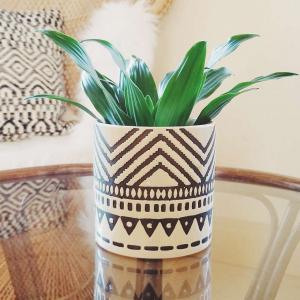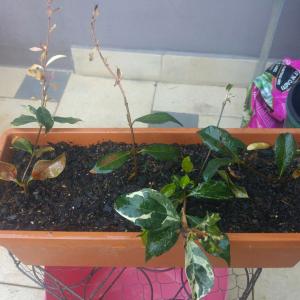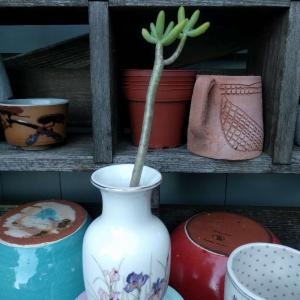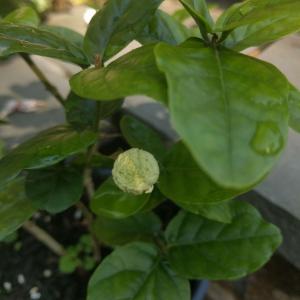成长记
lynns590
2017年09月30日

I new added a "Moon cactus and Crassula perforta variegata" in my "garden"


0
0
成长记
brielle
2017年09月30日

I new added a "Dracaena Deremensis - Janet Craig Compacta" in my "garden"


1
0
成长记
cclecombe
2017年09月30日

I new added a "Variegated Rubber Plant" in my "garden"


2
1
meriunkat:@cclecombe awesome and then you get the chance to watch it grow as well 😆
cclecombe:@meriunkat I know right! I was planning on getting a larger one from Amazon, but the flower stall on my local market were selling baby ones for £2.50 so I couldn't resist! It turns out it's better to get them small as they learn to acclimate to being a house plant much better than if you were to bring home a full grown one, so it's a win-win!
meriunkat:How cute!😄💚
文章
Dummer. ゛☀
2017年09月30日

Fuchsia are immensely popular outdoor plants throughout the English-speaking world. They were first imported from subtropical regions in South American and New Zealand into the United Kingdom in the late 18th century, and have subsequently been the focus of extensive hybridizing.
Today, there are Fuchsia available in a wide range of colors, with the bell-like flowers blooming in white, pink, red, purple or various combinations. They’ve also been bred as single, double, or semi-double flowers. And finally, they can be used in any number of situations, as trained standards, trailing baskets, or pots of colorful blooms. Long thought of as outdoor plants, indoor Fuchsia are often thrown away after their bloom is finished. In reality, they can be overwintered, and a new set of leaves and blooms will emerge next spring for another display.
Growing Conditions
Light: Fuchsia appreciate bright light, but should not be subjected to full sun unless you can keep the roots adequately moist and cool. Many people use Fuchsia as shade plants, which is fine, but as long as they get enough water, they can handle more light than many people assume.
Water: During the growing season, keep the soil continuously moist. Plants dislike hot, dry roots—this will kill them. So make sure the roots are cool and moist at all times. After the bloom is done, cut watering back in preparation for over-wintering the plant.
Temperature: Fuchsia thrive at around 70˚F (21˚C) and dislike being hot for too long. During the overwintering period, reduce temperature to 50˚F (10˚C) or 60˚F (15˚C).
Soil: A rich, fast-draining mix is ideal.
Fertilizer: Fertilize abundantly during the growing season. They are heavy feeders, and many container growers feed their plants with a weak liquid fertilizer at every watering (weekly) during the growing season. Controlled-release pellets are also an excellent option.
Repotting
Repot your Fuchsia in the spring annually. These plants require a rich supply of organic material to flower and perform their best, so even if you’re not stepping the plant up to a larger pot, you should repot it into a fresh pot with new soil. Add some controlled-release fertilizer pellets at repotting time to increase vigor.
Propagation
Fuchsia will propagate readily from leaf-tip cuttings. For best results, use a rooting hormone. After taking cuttings, leave the plants in a bright place with high humidity and keep the soil continuously moist, but not soaked. New growth should emerge within a few weeks. Do not repot cuttings until they are established.
Grower’s Tips
Fuchsia make excellent houseplants, in part because they are well adapted to growing in shadier conditions. In general, the more heat and light a Fuchsia is subjected to, the more careful you’ll have to be about watering. In some cases, you might be watering every day. To prevent fungal problems and pests, be careful not to let your Fuchsia leaves touch the dirt. Even then, whiteflies can be a problem for Fuchsia and should be treated at the first sign of an infestation (look for white webs on the undersides of leaves). When treating for whitefly, make sure to spray the undersides of leaves thoroughly to disrupt their life cycle. To overwinter your Fuchsia, let the leaves drop off in spring, reduce watering, and move it to a cool and dark room. New growth should appear in the spring.

Today, there are Fuchsia available in a wide range of colors, with the bell-like flowers blooming in white, pink, red, purple or various combinations. They’ve also been bred as single, double, or semi-double flowers. And finally, they can be used in any number of situations, as trained standards, trailing baskets, or pots of colorful blooms. Long thought of as outdoor plants, indoor Fuchsia are often thrown away after their bloom is finished. In reality, they can be overwintered, and a new set of leaves and blooms will emerge next spring for another display.

Growing Conditions
Light: Fuchsia appreciate bright light, but should not be subjected to full sun unless you can keep the roots adequately moist and cool. Many people use Fuchsia as shade plants, which is fine, but as long as they get enough water, they can handle more light than many people assume.
Water: During the growing season, keep the soil continuously moist. Plants dislike hot, dry roots—this will kill them. So make sure the roots are cool and moist at all times. After the bloom is done, cut watering back in preparation for over-wintering the plant.

Temperature: Fuchsia thrive at around 70˚F (21˚C) and dislike being hot for too long. During the overwintering period, reduce temperature to 50˚F (10˚C) or 60˚F (15˚C).
Soil: A rich, fast-draining mix is ideal.
Fertilizer: Fertilize abundantly during the growing season. They are heavy feeders, and many container growers feed their plants with a weak liquid fertilizer at every watering (weekly) during the growing season. Controlled-release pellets are also an excellent option.

Repotting
Repot your Fuchsia in the spring annually. These plants require a rich supply of organic material to flower and perform their best, so even if you’re not stepping the plant up to a larger pot, you should repot it into a fresh pot with new soil. Add some controlled-release fertilizer pellets at repotting time to increase vigor.

Propagation
Fuchsia will propagate readily from leaf-tip cuttings. For best results, use a rooting hormone. After taking cuttings, leave the plants in a bright place with high humidity and keep the soil continuously moist, but not soaked. New growth should emerge within a few weeks. Do not repot cuttings until they are established.

Grower’s Tips
Fuchsia make excellent houseplants, in part because they are well adapted to growing in shadier conditions. In general, the more heat and light a Fuchsia is subjected to, the more careful you’ll have to be about watering. In some cases, you might be watering every day. To prevent fungal problems and pests, be careful not to let your Fuchsia leaves touch the dirt. Even then, whiteflies can be a problem for Fuchsia and should be treated at the first sign of an infestation (look for white webs on the undersides of leaves). When treating for whitefly, make sure to spray the undersides of leaves thoroughly to disrupt their life cycle. To overwinter your Fuchsia, let the leaves drop off in spring, reduce watering, and move it to a cool and dark room. New growth should appear in the spring.
1
1
文章
Dummer. ゛☀
2017年09月30日

Thelymitra, commonly called Sun Orchids, is a genus of about 80 species of terrestrial tuberous plants in the Orchidaceae family distributed throughout Australia, New Zealand and islands to the north of Australia.
They are known as “Sun Orchids” because the colorful flowers of most species only open fully on warm, sunny days, with the desert species requiring more heat than those from temperate areas.
Members of the genus Thelymitra are perennial ground orchids, which die back to underground tubers during the warm dry months of the year. They have a single basal leaf and an erect inflorescence with up to 40 flowers. The flowers may be self-pollinating or insect-pollinated and open only on warm to hot days. Flowers are usually blue, pink, yellow or white, but may have darker spots or blotches or prominent longitudinal veins.
The number of flowers per stem is variable. Some, such as the Scented Sun Orchid, will have up to 30 flowers open on a single stem. Unlike other Australian orchids, this genus has sepals and petals nearly equal in length, with the lip similar to and spreading with them. They have a solitary leaf that is usually elongated and channeled. Species are identified by their color and their column.
Growing Conditions and General Care
Sun Orchids can be very tricky in cultivation. However, most are fairly amenable and some are very easy. All plants are summer dormant and rest as tuberoids. Plants emerge in late summer and flower in late winter, spring and early summer. Culture as sunny as possible. In milder climates garden culture is possible. Frost hardy up to 23°F (-5°C). Regular watering during the growing period is essential. Fertilize monthly until flowering. Reduce watering with the onset of flowers and stop as the leaves die back. Completely dry during dormancy. Occasionally a light spray of water for small plants and seedlings to prevent dehydration. If grown inside, move plants temporary outside in late summer as cool nights and some rain will stimulate plants into the new growing season.

They are known as “Sun Orchids” because the colorful flowers of most species only open fully on warm, sunny days, with the desert species requiring more heat than those from temperate areas.

Members of the genus Thelymitra are perennial ground orchids, which die back to underground tubers during the warm dry months of the year. They have a single basal leaf and an erect inflorescence with up to 40 flowers. The flowers may be self-pollinating or insect-pollinated and open only on warm to hot days. Flowers are usually blue, pink, yellow or white, but may have darker spots or blotches or prominent longitudinal veins.

The number of flowers per stem is variable. Some, such as the Scented Sun Orchid, will have up to 30 flowers open on a single stem. Unlike other Australian orchids, this genus has sepals and petals nearly equal in length, with the lip similar to and spreading with them. They have a solitary leaf that is usually elongated and channeled. Species are identified by their color and their column.

Growing Conditions and General Care
Sun Orchids can be very tricky in cultivation. However, most are fairly amenable and some are very easy. All plants are summer dormant and rest as tuberoids. Plants emerge in late summer and flower in late winter, spring and early summer. Culture as sunny as possible. In milder climates garden culture is possible. Frost hardy up to 23°F (-5°C). Regular watering during the growing period is essential. Fertilize monthly until flowering. Reduce watering with the onset of flowers and stop as the leaves die back. Completely dry during dormancy. Occasionally a light spray of water for small plants and seedlings to prevent dehydration. If grown inside, move plants temporary outside in late summer as cool nights and some rain will stimulate plants into the new growing season.
0
0


















